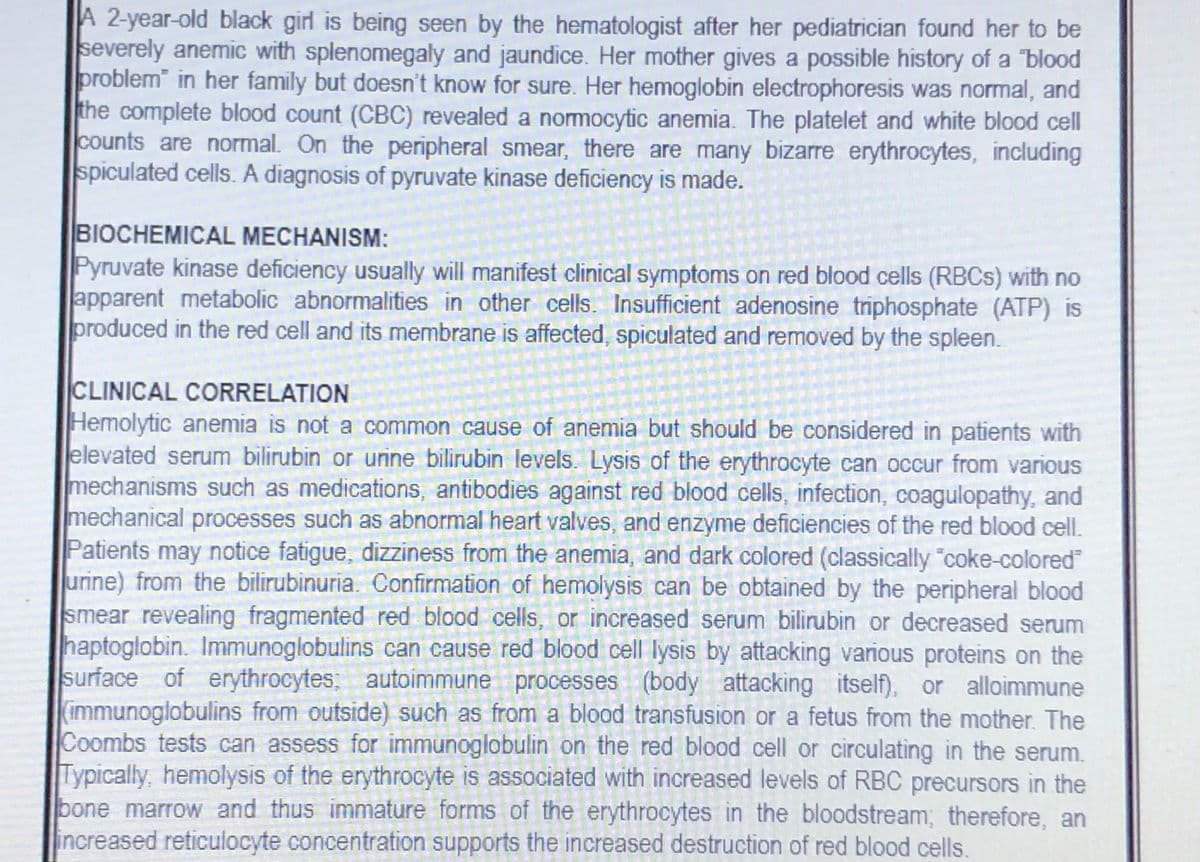In the RBCs of the patient in the picture, which of the following would be expected? Explain. A. ADP to ATP ratios would be elevated above normal B. NADP+ would increase relative to NADPH C. Ribulose 5-phosphate levels would increase D. NADH to NAD+ ratios would decrease E. Methemoglobin levels would increase
In the RBCs of the patient in the picture, which of the following would be expected? Explain. A. ADP to ATP ratios would be elevated above normal B. NADP+ would increase relative to NADPH C. Ribulose 5-phosphate levels would increase D. NADH to NAD+ ratios would decrease E. Methemoglobin levels would increase
Medical Terminology for Health Professions, Spiral bound Version (MindTap Course List)
8th Edition
ISBN:9781305634350
Author:Ann Ehrlich, Carol L. Schroeder, Laura Ehrlich, Katrina A. Schroeder
Publisher:Ann Ehrlich, Carol L. Schroeder, Laura Ehrlich, Katrina A. Schroeder
Chapter1: Introduction To Medical Terminology
Section: Chapter Questions
Problem 52LE: A fever is considered to be a ____________________________. prognosis sign symptom syndrome
Related questions
Question
In the RBCs of the patient in the picture, which of the following would be expected? Explain.
A. ADP to ATP ratios would be elevated above normal
B. NADP+ would increase relative to NADPH
C. Ribulose 5-phosphate levels would increase
D. NADH to NAD+ ratios would decrease
E. Methemoglobin levels would increase

Transcribed Image Text:A 2-year-old black girl is being seen by the hematologist after her pediatrician found her to be
severely anemic with splenomegaly and jaundice. Her mother gives a possible history of a "blood
problem" in her family but doesn't know for sure. Her hemoglobin electrophoresis was normal, and
the complete blood count (CBC) revealed a nomocytic anemia. The platelet and white blood cell
counts are normal. On the peripheral smear, there are many bizarre erythrocytes, including
spiculated cells. A diagnosis of pyruvate kinase deficiency is made.
BIOCHEMICAL MECHANISM:
Pyruvate kinase deficiency usually will manifest clinical symptoms on red blood cells (RBCS) with no
apparent metabolic abnormalities in other cells. Insufficient adenosine triphosphate (ATP) is
produced in the red cell and its membrane is affected, spiculated and removed by the spleen.
CLINICAL CORRELATION
Hemolytic anemia is not a common cause of anemia but should be considered in patients with
elevated serum bilirubin or unine bilirubin levels. Lysis of the erythrocyte can occur from various
mechanisms such as medications, antibodies against red blood cells, infection, coagulopathy, and
mechanical processes such as abnormal heart valves, and enzyme deficiencies of the red blood cell.
Patients may notice fatigue, dizziness from the anemia, and dark colored (classically "coke-colored
urine) from the bilirubinuria. Confirmation of hemolysis can be obtained by the peripheral blood
smear revealing fragmented red blood cells, or increased serum bilirubin or decreased serum
haptoglobin. Immunoglobulins can cause red blood cell lysis by attacking various proteins on the
surface of erythrocytes; autoimmune processes (body attacking itself), or alloimmune
(immunoglobulins from outside) such as from a blood transfusion or a fetus from the mother. The
Coombs tests can assess for immunoglobulin on the red blood cell or circulating in the serum.
Typically, hemolysis of the erythrocyte is associated with increased levels of RBC precursors in the
bone marrow and thus immature forms of the erythrocytes in the bloodstream; therefore, an
increased reticulocyte concentration supports the increased destruction of red blood cells.
Expert Solution
This question has been solved!
Explore an expertly crafted, step-by-step solution for a thorough understanding of key concepts.
Step by step
Solved in 4 steps

Recommended textbooks for you

Medical Terminology for Health Professions, Spira…
Health & Nutrition
ISBN:
9781305634350
Author:
Ann Ehrlich, Carol L. Schroeder, Laura Ehrlich, Katrina A. Schroeder
Publisher:
Cengage Learning

Medical Terminology for Health Professions, Spira…
Health & Nutrition
ISBN:
9781305634350
Author:
Ann Ehrlich, Carol L. Schroeder, Laura Ehrlich, Katrina A. Schroeder
Publisher:
Cengage Learning